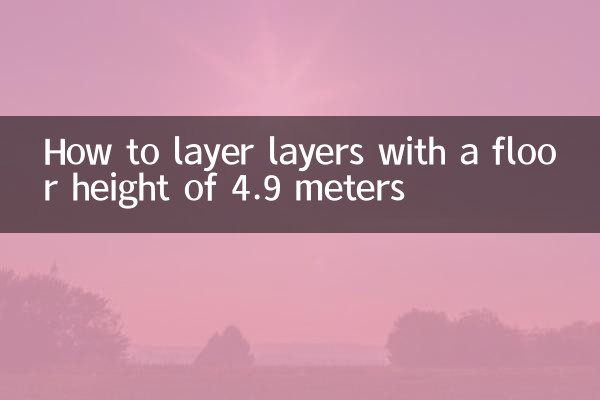How to layer layers with a floor height of 4.9 meters: analysis of practical design and hot trends
In recent years, with the popularity of loft units and small duplex apartments, how to layer a space with a floor height of 4.9 meters has become the focus of many owners and designers. This article will combine the hot topics and hot content on the Internet in the past 10 days to provide you with structured data and analysis to help you better plan your space.
1. Comparison of layered schemes with a floor height of 4.9 meters

| Layered scheme | Lower level height | upper floor height | Applicable scenarios | Advantages and Disadvantages |
|---|---|---|---|---|
| equal division method | 2.45 meters | 2.45 meters | Ordinary residence | The space is balanced, but the upper floors may be oppressive |
| High and low | 2.7 meters | 2.2 meters | commercial space | The lower level is comfortable and the upper level is suitable for storage or a children's room |
| low low high high | 2.2 meters | 2.7 meters | studio | Main activity area on the upper floor, auxiliary functions on the lower floor |
| mezzanine design | 3.0 meters | 1.9 meters | small apartment | Maximize use of space, but the upper floor is limited |
2. Recent popular layered design trends
According to the analysis of network hotspot data in the past 10 days, the following layered design trends have attracted much attention:
1.suspended staircase design: Save space while increasing aesthetics, becoming a check-in point for internet celebrities.
2.Transparent partition application: Use glass or acrylic material to separate the upper and lower floors to maintain a sense of transparency in the space.
3.Smart space transformation: The function of the space is converted through the electric lifting device. It becomes a high-ceiling living room during the day and a two-story bedroom at night.
4.vertical greening system: Set up green walls on layered walls to improve indoor air quality and enhance aesthetics.
3. Material selection and cost analysis
| Material type | Average price (yuan/㎡) | Construction difficulty | Service life | Recommended scenarios |
|---|---|---|---|---|
| steel structure | 800-1200 | medium | More than 20 years | Commercial space, long-term residential |
| Concrete cast in place | 600-900 | high | More than 30 years | permanent residence |
| wooden structure | 400-700 | low | 10-15 years | Temporary space, limited budget |
| composite materials | 500-800 | medium | 15-20 years | Lightweight requirements |
4. Practical suggestions and precautions
1.Safety first: Layered design must consider load-bearing capacity and structural safety. It is recommended to consult a professional structural engineer.
2.Lighting and ventilation: The upper space is prone to dark areas, so windows need to be planned appropriately or light-transmitting materials should be used.
3.Movement route planning: The location of the stairs should facilitate communication between the upper and lower floors without affecting the main activity area.
4.storage space: Use areas under the stairs, on the edge of the mezzanine and other areas to add storage functions.
5.regulatory restrictions: Some areas have clear regulations on residential stratification, so you need to understand the local building codes in advance.
5. Case sharing: 4.9-meter-high floor-height renovation recently popular on the Internet
1.Shanghai 28㎡ micro duplex: It adopts a 2.6-meter-low and 2.3-meter-high layer structure. The lower floor is the kitchen, bathroom and living room, and the upper floor is the bedroom. It won the 2023 Small House Design Award.
2.Hangzhou internet celebrity coffee shop: Utilizing a floor height of 4.9 meters to create a three-story seating area, each floor is 1.6 meters, forming a unique vertical social space.
3.Guangzhou shared office space: The intelligent lifting system enables full openness during the day and is layered into independent office units at night.
Through the above analysis and data, I hope it can provide valuable reference for your 4.9-meter-high layered design. No matter which plan you choose, you should combine your own needs, budget and usage scenarios to create a three-dimensional space that is both practical and beautiful.

check the details

check the details